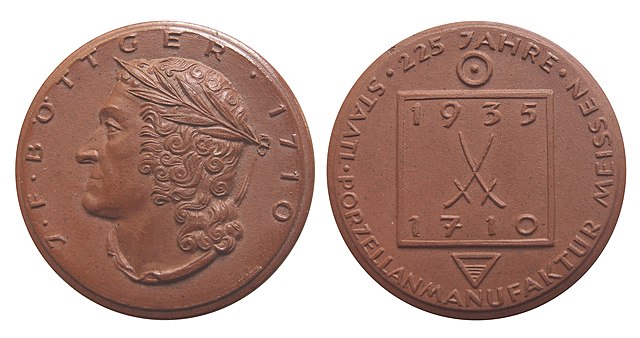Meissen porcelain or Meissen china was the first European hard-paste porcelain. Early experiments were done in 1708 by Ehrenfried Walther von Tschirnhaus. After his death that October, Johann Friedrich Böttger continued von Tschirnhaus's work and brought this type of porcelain to the market, financed by Augustus the Strong, King of Poland and Elector of Saxony. The production of porcelain in the royal factory at Meissen, near Dresden, started in 1710 and attracted artists and artisans to establish, arguably, the most famous porcelain manufacturer known throughout the world. Its signature logo, the crossed swords, was introduced in 1720 to protect its production; the mark of the swords is reportedly one of the oldest trademarks in existence.
Commedia dell'arte figures, c. 1740, 1744, 1735, modelled by Johann Joachim Kändler
Part of a tea and chocolate service, c. 1725, given to Vittorio Amadeo II, King of Sardinia (1666–1732) by Augustus the Strong, owner of the Meissen factory
Albrechtsburg castle in Meissen
Böttger stoneware medal of 1935 for the 225th anniversary of the factory in Meissen; the obverse portrays the inventor of the stoneware, Johann Friedrich Böttger
Hard-paste porcelain, sometimes called "true porcelain", is a ceramic material that was originally made from a compound of the feldspathic rock petuntse and kaolin fired at a very high temperature, usually around 1400 °C. It was first made in China around the 7th or 8th century and has remained the most common type of Chinese porcelain.
Porcelain dish, Chinese Qing, 1644–1911, Hard-paste decorated in underglaze cobalt blue V&A Museum no. 491-1931 Victoria and Albert Museum, London
Section of the letter of François Xavier d'Entrecolles about Chinese porcelain manufacturing techniques, 1712, published by Jean-Baptiste du Halde in 1735.
French porcelain factory, 1771.
Comte de Milly's L'art de la porcelaine, 1771.








